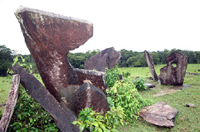Tropical Stonehenge discovered in Brazil
A grouping of granite blocks along a grassy Amazon hilltop may be the vestiges of a centuries-old astronomical observatory - a find archaeologists say indicates early rainforest inhabitants were more sophisticated than previously believed.

The 127 blocks, some as high as 9 feet tall, are spaced at regular intervals around the hill, like a crown 100 feet in diameter.
On the shortest day of the year - Dec. 21 - the shadow of one of the blocks, which is set at an angle, disappears.
"It is this block's alignment with the winter solstice that leads us to believe the site was once an astronomical observatory,'' said Mariana Petry Cabral, an archaeologist at the Amapa State Scientific and Technical Research Institute. "We may be also looking at the remnants of a sophisticated culture.''
Anthropologists have long known that local indigenous populations were acute observers of the stars and sun. But the discovery of a physical structure that appears to incorporate this knowledge suggests pre-Columbian Indians in the Amazon rainforest may have been more sophisticated than previously suspected.
"Transforming this kind of knowledge into a monument; the transformation of something ephemeral into something concrete, could indicate the existence of a larger population and of a more complex social organization,'' Cabral said.
Cabral has been studying the site, near the village of Calcoene , just north of the equator in Amapa state in far northern Brazil , since last year. She believes it was once inhabited by the ancestors of the Palikur Indians, and while the blocks have not yet been submitted to carbon dating, she says pottery shards near the site indicate they are pre-Columbian and maybe older -- as much as 2,000 years old.
Last month, archaeologists working on a hillside north of Lima , Peru , announced the discovery of the oldest astronomical observatory in the Western Hemisphere -- giant stone carvings, apparently 4,200 years old, that align with sunrise and sunset on Dec. 21.
That stunning discovery means pre-Incan American civilizations were building sophisticated temples and carving crazy faces into giant stone slabs more than 4,000 years ago -- the same time Britian's fur-clad semi-humans were feeling all proud about standing some crude rocks in a circle, sploid.com reports.
While the Incas, Mayans and Aztecs built large cities and huge rock structures, pre-Columbian Amazon societies built smaller settlements of wood and clay that quickly deteriorated in the hot, humid Amazon climate, disappearing centuries ago, archaeologists say.
Farmers and fishermen in the region around the Amazon site have long known about it, and the local press has dubbed it the "tropical Stonehenge .'' Archeologists got involved last year after geographers and geologists did a socio-economic survey of the area, by footand helicopter, andnoticed "the unique circular structure on top of the hill,'' Cabral said.
Scientists not involved in the discovery said it could prove valuable to understanding pre-Columbian societies in the Amazon.
"No one has ever described something like this before. This is an extremely novel find -- a one of a kind type of thing,'' said Michael Heckenberger of the University of Florida 's Department of Anthropology.
He said that while carbon dating and further excavation must be carried out, the find adds to a growing body of thought among archaeologists that prehistory in the Amazon region was more varied than had been believed.
"Given that astronomical objects, stars, constellations etc., have a major importance in much of Amazonian mythology and cosmology, it does not in any way surprise me that such an observatory exists,'' said Richard Callaghan, a professor of geography, anthropology and archaeology at the University of Calgary.
Brazilian archaeologists will return in August, when the rainy season ends, to carry out carbon dating and further excavations, the AP reports.
Ancient people who built Stonehenge more than 3,500 years ago could have used the monumental arrangement of pillars to predict lunar eclipses, according to a professor of physics and astronomy at Clarion University in Pennsylvania .
Sharon Challener, who has been studying the megalith for more than 20 years, discovered a pattern in the puzzling horseshoe-shaped row of vertical columns at Stonehenge's center. Challener, like so many others, had been trying for years to figure out what was the purpose of Stonehenge . She had speculated about, and tested out, countless celestial cycles as they may have lined up with the mysterious stones. Then, almost by accident, she noticed that eclipses are visible from certain locations on Earth in distinct 47-month cycles.
That seemed to add up. There were 19 upright columns at the monument's center, which are collectively called the Bluestone Horseshoe. If the Stonehengers placed some stone marker on top of a pillar at one end of the horseshoe during a lunar eclipse and moved the rock to the adjacent pillar every full moon, they could predict successive eclipses.
Moving the rock this way every lunar month, the marker would stand at the center of the horseshoe after two-and-a-half trips around the row -- 47 months after the original eclipse. The full moon that rose that month would fall into Earth's shadow during the night. That stone could then be taken down and moved to the beginning of the horseshoe again.
While it might sound complicated, the method would actually be simple in practice, Challener said, and it would work, space.com reports.
Source: agencies
Prepared by Alexander Timoshik
Pravda.ru
Discuss this article on Pravda.ru English Forum
Subscribe to Pravda.Ru Telegram channel, Facebook, RSS!




